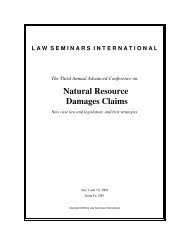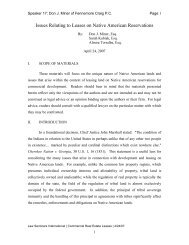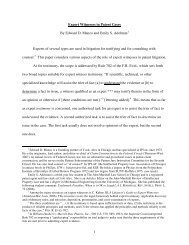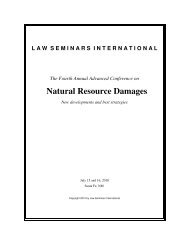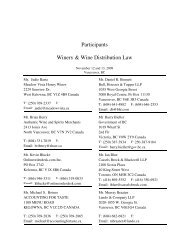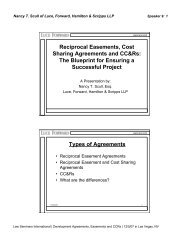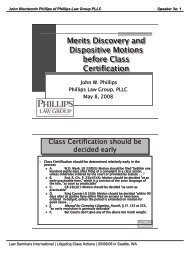LSI 2010 Real Estate Joint Ventures conference materials.pdf
LSI 2010 Real Estate Joint Ventures conference materials.pdf
LSI 2010 Real Estate Joint Ventures conference materials.pdf
Create successful ePaper yourself
Turn your PDF publications into a flip-book with our unique Google optimized e-Paper software.
David E. Myre, Jr. of Hillis Clark Martin & Peterson, P.S.<br />
Jane Rakay Nelson of Lane Powell PC<br />
Speaker 9b: 6<br />
Speaker 10b: 6<br />
Investor: I seem to have touched a nerve. Well, as to the enforceability, these<br />
terms are quite typical and are specifically authorized by Delaware law. It’s a<br />
little unusual, but you may have noticed that I attached a copy of the pertinent<br />
section of the Delaware statute---section 18-502(c)---to the Term Sheet as an<br />
exhibit. Take a look.<br />
Tell you what. Let’s postpone further discussion of this last topic until we<br />
come back to the “removal” and “Default” provisions later in the Term Sheet.<br />
Investor is concerned about the scenarios of the Project running into serious<br />
trouble, Developer deciding to “give up” on the Project, and intentionally<br />
refusing to honor a series of additional capital calls. And Investor not being<br />
able to dislodge Developer and take control of the mess. But let’s try to address<br />
that concern when we get to the subject of Manager removal and Member<br />
default.<br />
Developer: Okay. One last question. I gather from the Term Sheet that Investor<br />
proposes a different, much simpler approach to the subject of additional capital<br />
contributions after the JV achieves Project Stabilization. Why is that?<br />
Investor: Three reasons. First, once it hits Project Stabilization, the JV has passed<br />
through a phase of relatively high risk and into a period of much lower risk.<br />
Almost all of the development, construction and lease-up risks will be behind<br />
us. The most likely scenario leading to an equity capital shortfall after Project<br />
Stabilization would probably be an uninsured casualty, or a design or<br />
construction defect not covered by the warranties, or a major lease rollover<br />
requiring substantial, unanticipated tenant improvements. So, generally<br />
speaking, Investor feels there will be much less likelihood of needing to make<br />
unforeseen additional capital contributions after Project Stabilization.<br />
Second, soon after Project Stabilization the JV will refinance the Construction<br />
Loan with the Term Loan described in the Term Sheet. Investor anticipates<br />
that, unlike the Construction Loan, the Term Loan will permit subordinate<br />
financing for the Project, at least if it is an unsecured loan to the Company. So<br />
we will be able to use a simpler structure to deal with the scenario if a Member<br />
decides not to make an additional capital contribution – namely, a direct loan by<br />
the other Member to the JV.<br />
Third, as mentioned in the Term Sheet, the JV agreement will provide that, after<br />
Project Stabilization, the Members will go through an annual process of<br />
mutually approving an annual budget and annual business plan for the<br />
DWT 12265643v1 0000099-071219<br />
6<br />
Law Seminars International | <strong>Real</strong> <strong>Estate</strong> <strong>Joint</strong> <strong>Ventures</strong> and Funds | 02/08/10 in Seattle, WA





